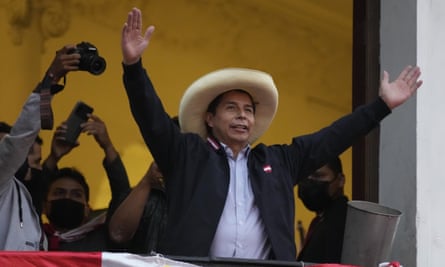Keiko Fujimori, one of the two candidates fighting vote by vote for the presidency of Peru, has alleged fraud and irregularities in the count of Sunday’s election as her rival, leftist teacher Pedro Castillo, widens a narrow lead.
An inter-American observer mission did not report any irregularities and said the ballot passed off correctly, complying with international standards.
With more than 97% of the official vote counted, the hard-left candidate Castillo holds a razor-thin lead of about 0.4% over his far-right opponent, an advantage of about 70,000 votes.
But at a late press conference on Monday, Fujimori, 46, claimed there had been a “series of irregularities which worry us and we think it’s important to highlight”.
She accused Castillo’s party, Perú Libre, of using a strategy to “distort and delay the results which reflect the popular will” by challenging ballot tallies that, she alleged, had favoured her party Fuerza Popular.
Later on Monday night, Castillo addressed a large crowd of supporters from a balcony in downtown Lima. “We should be respectful of the people’s will,” he shouted through a megaphone. “I will be the first to make sure the will of the Peruvian people is being respected.”
Fujimori’s remarks have attracted criticism from political figures and analysts who have described it as an act of desperation as she appears to be on the verge of losing her third election runoff in 10 years.
“It’s extremely regrettable that when the result is not favourable, that the candidate talks about fraud. It’s terrible,” Fernando Tuesta, a political science professor at Lima’s Pontifical Catholic University, told national radio broadcaster RPP on Monday night. “They have been talking about fraud because they don’t want to respect the result,” he said.
Fujimori, the daughter of the jailed former president Alberto Fujimori, narrowly lost second-round elections in 2011 against Ollanta Humala by just 3% of the vote, then in 2016 to Pedro Pablo Kuczynski by an even slimmer margin.
As a candidate, Fujimori’s father – who is serving a 25-year sentence over corruption and death squad murders – and her own record as a politician play against her.

Fujimori has also racked up accusations of graft, accused of receiving more than $17m in illegal campaign funds and heading a criminal organisation, and could face a 30-year jail term if convicted. She denies the allegations, which she describes as politically motivated.
Before the ballot count began, Nicolas Saldias, Latin America and the Caribbean analyst at the Economist Intelligence Unit, predicted a tight result “could be contested amid accusations of fraud”.
“Whoever wins the election will have a very weak electoral mandate that will make governing exceptionally difficult as neither Castillo nor Fujimori has a legislative majority,” Saldias said.
The vote in the Covid-battered nation has split the country between the poor, rural Andes and the wealthier and more urban northern coast and capital Lima. It comes amid one of the worst economic slowdowns in the region, which has pushed nearly 10% of Peru’s population into poverty, millions into unemployment and prompted many others to leave major cities and return to their rural villages.
